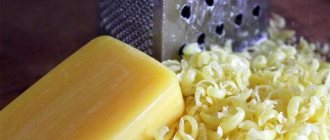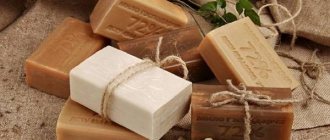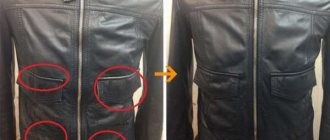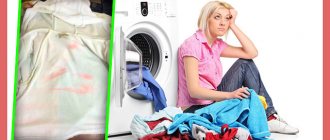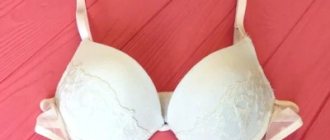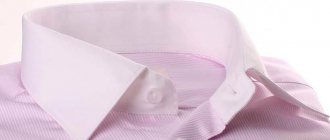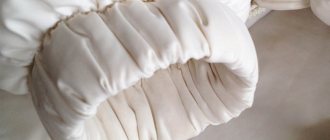Sweat can penetrate deep into fabric fibers
Do sweat marks literally force you to constantly throw away your favorite things? They are very difficult to wash, but this does not mean that it is time for a T-shirt or jumper to retire. Constantly emptying your closet will not allow you to save money for anything you need, and many people are accustomed to turning to dry cleaning services only in exceptional cases. Don't panic - traces and smells of sweat can be removed from your favorite clothes yourself, even at home. Fortunately, today there are quite a large number of ways to solve this delicate problem.
How to remove sweat stains from underarms
Sweat stains can appear on clothes of different colors. It all depends on how much a person sweats, what components are contained in his sweat, and how brightly they manifest themselves on the fabric. The main problem with such stains is that they are corrosive. It is impossible to remove them either with high-quality washing in an automatic machine or with the help of bleaches. You don’t want to throw away the thing at all, so you need to choose the best option that will solve the problem.
Before using one or another version of the product on different types of fabric, it should be applied to a small area of the fabric from the inside, where it will not be noticeable. This way, it will be possible to evaluate the result and not spoil the thing.
Fresh spots
The easiest way to deal with fresh stains. While they have just appeared, are not yet so contrasting in color and have not yet become completely ingrained, it is necessary to launch heavy artillery against them in the form of various improvised means.
Old stains
With old stains it will be more difficult. You will have to tinker with them longer and it is not a fact that they will be completely cleaned.
It must be remembered that there are a number of means that one’s hand is reaching out to, but they cannot be used. These are chlorine-containing preparations, because due to the reaction that occurs when exposed to proteins in sweat and chlorine, the fabric begins to darken. In addition, you cannot wash such an item in hot water (the water temperature during washing is allowed no more than 30 degrees).
Precautionary measures
To combat products effectively and safely, you must follow a few simple rules:
- Always pay attention to the care rules and recommendations, which must be sewn to the tag on the inside of the item.
- Also follow the instructions for stain removers and bleaches.
- If you cannot determine the type of tissue, it is better not to take risks and use only a universal oxygen agent. Otherwise, removing the stain may lead to its final fixation on the fabric or removal of paint in the armpit area.
- It is prohibited to use chlorine-containing bleaches for any synthetics, too thin items made from natural fabrics, as well as natural silk..
- If the product is strongly rubbed during cleaning, the fabric may become thinner or the weave structure may be disrupted, which will lead to tears and holes.
- By constantly using chlorine-containing bleaches, we risk reducing the wear life of the product. After all, chlorine, penetrating deeply into the fibers, not only quickly bleaches them, but also quickly thins them.
Removing stains from different fabrics
To choose a tactic for cleaning fabric, you should pay special and primary attention to the fabric from which the item is made. After all, what is suitable for processing cotton will not work with synthetics.
Cotton and linen
Cotton, as well as linen, is an unpretentious fabric. Therefore, here you can afford more than with delicate synthetic, silk or woolen options. At home, you can clean a cotton item in the following ways:
- Using ammonia and salt: prepare the mixture by diluting 1 tsp. salt and the same amount of ammonia in a glass of water, then thoroughly treat the damaged area on the clothing with this mixture, leave for 15 minutes
- Using citric acid: dilute a teaspoon of the product in a glass of water, then treat the stains and leave for 2 hours (alternatively, you can use vinegar)
- Using vodka or vinegar: you should collect a proportion of one part vodka (vinegar) and water, and then treat the stains
After each of these options, clothes should be thoroughly washed and rinsed.
Silk
Silk is a noble and delicate fabric, so you need to act carefully. The following 2 options are suitable:
- Rub the dirty area with laundry soap. Then you should prepare a solution of hydrogen peroxide, which is applied to the stain on top. Next, all that remains is to rinse the fabric well in water, the result will not be long in coming: the stain will lighten.
- Another option is to use a sodium hyposulfate solution. It needs to be dissolved in the amount of 1 tbsp. per glass of water. The stain is treated with this solution, after which the clothes are put aside for 20 minutes. Afterwards, you need to rinse it thoroughly and more than once.
It is worth understanding that silk items cannot be treated with options such as vinegar and acetone.
Wool
Coat spots can also be very noticeable. But you have to work with it very carefully. If the need arises, regular salt should be used. To prepare the solution you will need:
- 5 tablespoons salt
- Glass of water
They are mixed and then applied to the stain. Next, all that remains is to let the clothes dry and then apply alcohol or vodka. After subsequent washing, the stains should disappear.
Synthetics
Synthetics allow you to cope with the problem quite quickly - it is easily amenable to various manipulations. As a rule, laundry soap is enough to rub all dirty areas to get rid of stains. After rubbing with soap, the item should be left for 15 minutes and then washed.
Note to housewives:
- Chlorine is not suitable for bleaching. Reacting with the proteins of “sweat” spots, it leads to darkening of the tissue in these areas.
- It is not recommended to rub clothes vigorously when removing stains to avoid damaging the dyes.
- Acetone and acetic acid are prohibited for removing stains on silk acetate.
- Solvents such as gasoline, benzene, etc. – prohibited for synthetics (nylon, nylon, etc.).
- It is not recommended to remove stains from cotton fabrics with strong acids (hydrochloric, nitric), and from wool and silk - with alkali.
- each new method on a piece of fabric that, if accidentally damaged, will not ruin the appearance of the clothing.
- Hot water fixes stains! It is recommended to wash shirts/blouses at 30 degrees and then air dry.
- It is recommended to remove stains from the inside of clothing to avoid streaks appearing around the stains. To protect clothing from this effect, you can moisten the cloth around the stain when removing it or sprinkle it with chalk.
- When using hydrogen peroxide, you should rinse your clothes several times - under the sun, peroxide leaves a yellow tint on clothes!
Well, one last piece of advice: avoid antiperspirant deodorants that contain a component that promotes staining - Aluminum Zirconium Tetrachlorohydrex Gly.
If you liked our article and have any thoughts on this matter, share with us! It is very important for us to know your opinion!
Removing sweat stains using improvised means
You can remove sweat stains using various preparations that you may have on hand. Some of them are kept in first aid kits, others in the refrigerator, and others in kitchen cabinets. So, the list of suitable cleansers includes:
- Aspirin;
- Salt;
- Ammonia;
- Lemon and citric acid;
- Vinegar;
- Vodka;
- Boiling;
- Soda, etc.
Each of them shows its own effect.
Aspirin and methenamine
Aspirin tablets take a little longer to act than peroxide, but the effect is noticeable. You need to crush several pieces into crumbs and apply them to a pre-moistened stain. It will turn out to be a paste. Leave it like this for 4 hours, then wash the item as usual.
Another pharmaceutical drug that helps cope with the problem is methenamine. It needs to be added directly to the machine before washing, but you should understand that its effect is immediate.
Salt and ammonia
Table salt together with ammonia perfectly relieves the problem. To do this, you need to combine a glass of water and a teaspoon of salt with the same amount of ammonia. Moisten the stain with the resulting product. At the end of the procedure, clothes should be rinsed.
You can also deal with sweat stains using ammonia in combination with alcohol. They must be mixed in equal proportions and applied to the stain, left for 15 minutes. If the solution evaporates quickly, it should be processed again. The clothes are then washed in cold water.
Lemon (citric acid) and vinegar
Lemon juice, due to its concentration, copes well with the problem of spots under the arms. So, with the help of lemon, you can clean stains by mixing the juice of the fruit with water in equal proportions. Alternatively, you can make a mixture of half a glass of baking soda and the juice of half a lemon. It remains to be applied to the stains and rubbed with your hands until completely absorbed. Then leave for an hour and wash.
Using vinegar, you can treat sweat marks with a cotton pad. Leave the clothes for an hour, then wash. To wash synthetic colored clothes, you need to prepare a solution from vinegar, and not use pure acid.
Vodka
You can clean clothes with vodka. This method works when there are whitish marks on black. Soak a cotton pad in vodka and wipe the stain, then wash it.
Laundry soap and dishwashing liquid
One of the popular methods is the use of laundry soap. You can make a soap solution by grating soap and diluting it with water, or you can simply rub the stain. Apply soap to the armpit area and let it sit for half an hour; after treatment, wash the item.
Using the same scheme, you can use regular dishwashing liquid.
Soda
Another option that is widely used is baking soda. It works great on whites and can be used on a variety of fabrics. Baking soda additionally removes the smell of sweat from clothes. Prepare the cleaning agent as follows:
- Take half a glass of water.
- 4 tablespoons of soda are mixed in it.
- Then you need to treat the stains and leave it like that for a couple of hours.
Gasoline or ammonia
You should not use boiling water, gasoline or ammonia to clean sweat stains on clothes. After all, you can ruin the fabric irrevocably. Plus, such methods are not the safest, because... You may be scalded or experience dermatological irritation.
Denatured alcohol + yolk
This combination helps clean any colored fabrics. But you should work with it more carefully. Mix the two products together and apply to the fabric, leave for a while, then wash.
Cleaning linen and cotton
If sweat has become ingrained in linen and cotton clothes, you can use the following recipe:
- You need to take baking soda, salt and liquid soap,
- Mix everything to get a thick mixture,
- Add ammonia and apply the composition to the contaminated areas of the fabric,
- Leave the laundry in this state for 30 minutes, then wash the item using the usual method.
Note! The faster an item with sweat stains is washed, the better the washing effect will be.
To urgently remove old stains from sweating from cotton clothes in white colors, you need to use table vinegar 9%.
- Apply vinegar to the marks.
- Leave the item for a couple of minutes.
- Rinse the item under clean water.
Thanks to vinegar, you can quickly remove stains from cotton items.
Preventing stains
It is worth taking preventive measures. To do this you need to follow a simple list:
- Be sure to follow the rules of personal hygiene - you should wash more often and use deodorants.
- Using special pads for the armpits. They work on the principle of panty liners, absorbing all the secretions. They should be attached to clothing. You can buy these at any pharmacies.
- Refusal of synthetics - it is better to give preference to linen and cotton.
- Nutrition correction: to reduce sweat production, you need to exclude spicy foods, alcohol, strong drinks, such as tea and coffee, from your diet.
- Daily change of clothes.
- Wash stained clothes immediately rather than later.
It is quite possible to deal with sweat stains on clothes. The main thing is to approach the process wisely and not delay it. And then the thing will serve for a long time and will look like new.
Reviews
Dear readers, your opinion is very important to us - therefore, we will be glad to hear your feedback on removing sweat stains from clothes in the comments; this will also be useful to other users of the site.
Alexei:
I'm sweating terribly, only Teymur's paste saves me. My wife somehow magically washes things, but I don’t delve into her secrets.
Anna:
All the deodorants I've tried have left marks on my things. But I have no problems with removing marks; I wash them with Ariel capsules.
Useful tips
To ensure that your favorite things remain as good as new for as long as possible, you need to follow simple rules:
- Before using this or that recipe against yellowness on things, you need to make sure that the chosen product will not harm the material. To do this, you need to read the product label and test the product on an inconspicuous area of the item, for example, under the collar.
- Before removing the yellowness, things need to be cleaned of dust. To do this, first clean the product with a dry brush and then with a damp one.
- If the yellowness shows through, then it is best to start removing it from the wrong side. Only then is the material processed from the face.
- To prevent the yellowness from spreading even further during treatment with solutions, they begin to remove it from the edges to the center. If you do not follow this advice, you can completely ruin the item.
There are many ways and home remedies that you can use to deal with the yellowness that appears on blouses or blouses. All you have to do is choose the recipe that suits you best and start rescuing your favorite clothes.
Preventive measures
Stubborn stains from antiperspirants and deodorants cause a lot of trouble. They are difficult to remove and much easier to prevent if you follow preventive recommendations. Proper use of deodorants makes it possible to avoid problems. More details:
- It is necessary to give preference to quality products. Despite the fact that their cost can be several times higher, they are much more economical to use.
- Don't overuse antiperspirant. A thin, moderate layer is enough to protect yourself from odor and traces of sweat all day long.
- When using sprays, they should be sprayed from a distance of at least 20 cm.
- Before using deodorant, the skin must be completely dry and clean. It is important.
- Gels and sticks dry in about 10 minutes, and aerosols in about 5. You can put on clothes only after the deodorant has completely dried.
Expert opinion
Irina. Housewife.
Ask a Question
Important! If the antiperspirant takes too long to dry, it means your skin was damp when you applied it. In this case, blot your armpits with a dry paper towel and repeat applying the product to the skin.
White stains from deodorants and antiperspirants on colored and black clothes are classified as complex stains. The molecules of the products penetrate deeply into the fibers of fabrics and have water-repellent properties.
This is why it is so difficult to get rid of them. You can remove traces of deodorant using any of the described products.
